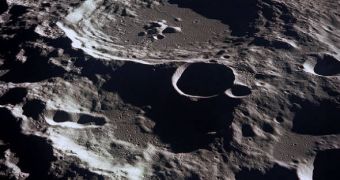The television team at the Goddard Space Flight Center in Greenbelt, Maryland, has just finished its work on a new short clip, entitled “Return to the Moon,” which is scheduled to air on February 27th throughout the United States. It has also shrunk the Moon to a 6 foot-tall model, and placed it inside its Visitor Center, for public display. The initiative is part of the Science On a Sphere platform, and is scheduled to tour the country in science museums and on selected locations.
“Goddard's Scientific Visualization Studio takes enormous, highly-technical data sets from various NASA missions and turns them into stunning imagery, while the Goddard Television team takes complex scientific subjects and translates them into succinct, compelling features. Just as NASA prides itself at pushing back the boundaries of exploration, we take pride in inventing new ways to communicate the results of that exploration,” the producer of the new movie, Michael Starobin, who is working for the Goddard Television, says.
“Spherical film making brings the moon and planetary science down to Earth,” he adds, pinpointing that the film takes imagery and other data from the Apollo and Clementine missions, as well as from others. All the data will be projected on the 6 foot-tall fake Moon, which will appear to be magically hanging in the air in all locations that will air the film. Though the sequence only lasts for about 5 minutes, the researchers say that there is enough data inside to make sure that people understand why NASA is so eager to go back to the Moon.
Experts at the Goddard Center opine that the current level of knowledge on the Moon, although it may seem impressive, is actually nothing compared to what awaits the team on Earth's natural satellite. In the near future, the American space agency's next robotic mission, the Lunar Reconnaissance Orbitor, or LRO, will again circle our neighbor, sending back precious information as to what caused the weird landscape on it, what kind of rocks are there and how they were formed, as well as various atmosphere-related readings.
To overcome the technological difficulties imposed by projecting images on a perfect sphere, the Goddard team advises museums to use a central computer, hooked up to four projectors, situated at equal lengths from each other and from the sphere. By splitting images larger than those belonging to the HD format in four, the computer can combine them flawlessly, so that they look exactly like the Moon is coming to life before the spectators' eyes.

 14 DAY TRIAL //
14 DAY TRIAL //